
Yes, the Lincoln of this era was a fierce competitor in the famous Mexican road race, finishing 1-2-3-4 in not only 1952 but also 1953. Lincoln most certainly got a lot of free press from this. But I always wondered if it actually translated to a measurable uptick in sales. Were most folks who were race fans buy Lincolns? Or did they have the more usual suspects, say an Olds Rocket 88, or maybe an MG, Triumph, Austin-Healey or Porsche?
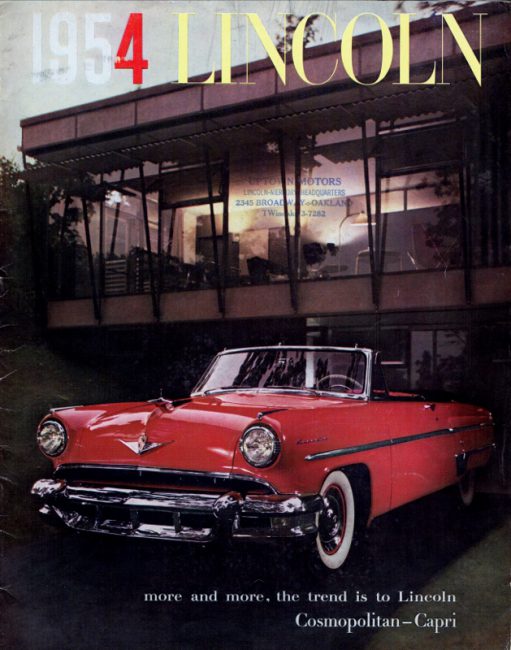
At any rate, for all their prowess, power and handling in races, these were still Lincolns at the end of the day, and promoted as such. Comfort, elegance, quietness, and plenty of power assists were still heavily promoted in sales literature and advertising.
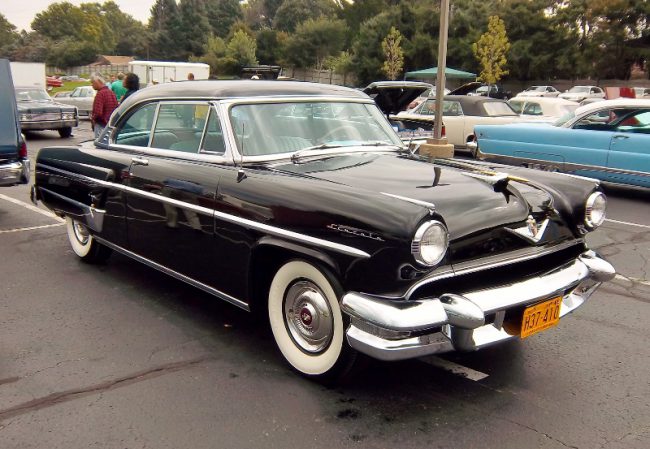
First appearing in 1952, these not only replaced the “bathtub” 1949-51 models, but also featured the very first Lincoln hardtop, as previously mentioned. It was available in your choice of Cosmopolitan (nice) or Capri (nicer) models.
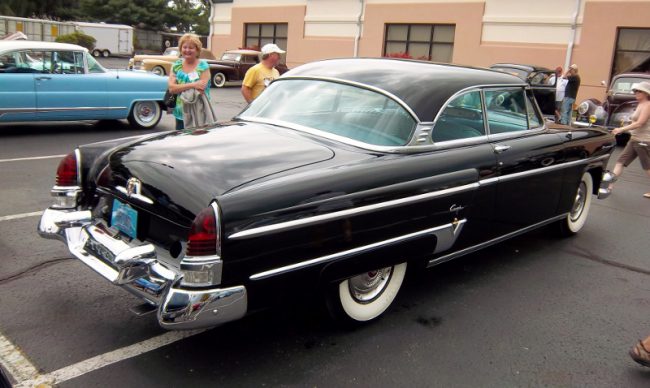
Despite the options and 123-inch wheelbase, however, there was no denying the close family resemblance between these Lincolns and lesser Fords and Mercurys. However, the overall design was very attractive, and the more powerful 317.5 CID V8 with four-barrel Holley provided ample power for the mid Fifties, with 205 horsepower. That was certainly an improvement over the ’52 Lincoln engine, which had only 160 horses with two-barrel carburetors.
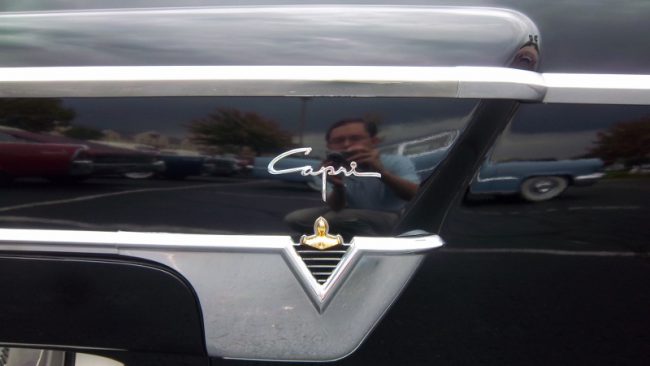
Despite the common corporate look, the Lincoln distinguished itself with the most mature version of the theme, and had lots of chrome jewelry, such as this elegant Capri script on the rear quarter panel. This is my favorite feature.
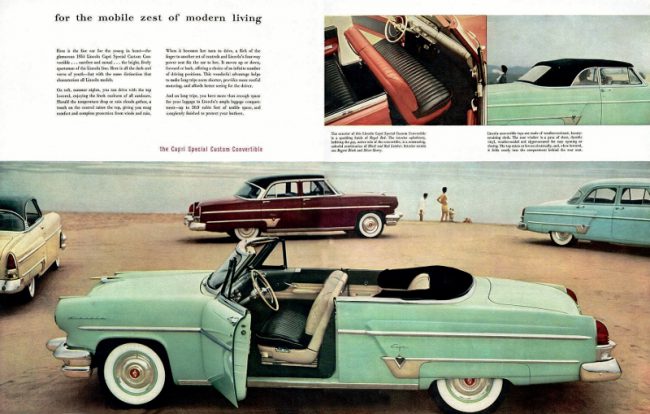
While the 1952-53 Lincolns were virtually identical, the 1954 model received more noticeable changes. gaining an inch in both length and width.

More substantial bumpers, a full-length side molding instead of the earlier one starting behind the front wheel, new wheel covers and other assorted trim bits.

Inside, it was clear that you were not in a Ford Customline. Lots of chrome bits, two-tone upholstery and elegant door panels made it clear this was a premium automobile. Lincoln’s finest. As a Capri, this was the nicest interior you could get from Ford Motor Company at the time.
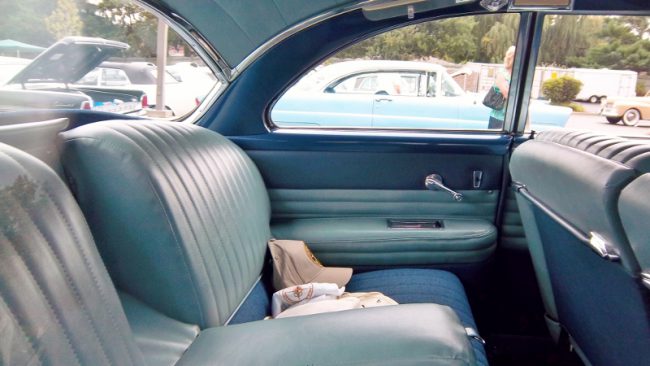
As a matter of fact, the 1954 Lincoln Capri two-door hardtop was the most popular Lincoln of the year, with 14,003 of the $3869 coupes being made. The rarest model, not unsurprisingly due to its being the most expensive Lincoln, was the Capri convertible–the only topless Lincoln available that year. Only 1,951 found buyers.
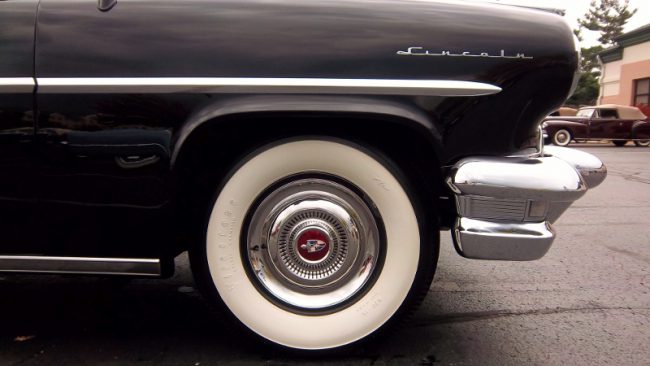
1954 was the final year of the Carrera Panamericana, and during this event, Lincolns “only” finished in first and second place, rather than the 1-2-3-4 sweep of 1952-53
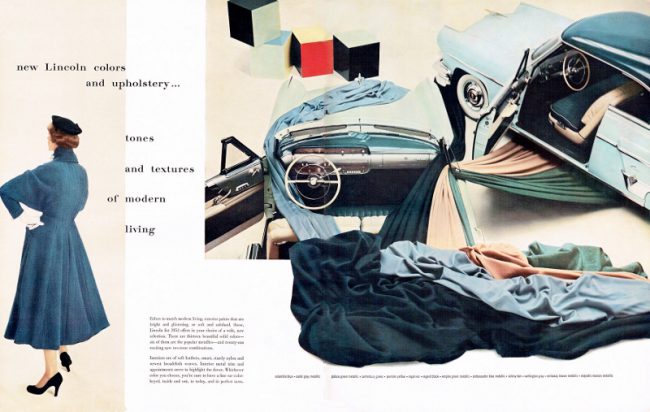
While the 1955 Lincoln would still use the 1952 body shell (albeit with one, final facelift-but no trendy wraparound windshield), there would be no more road racing victories.
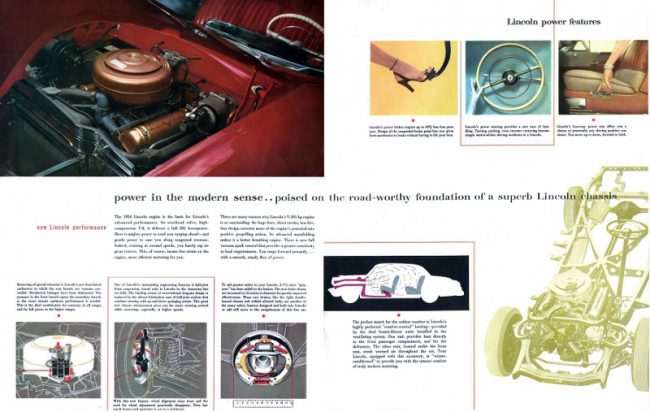
Just as well, as the remarkable 1956 Lincoln was waiting in the wings to take over. It would be even more elegant and luxurious than the 1952-55 model.
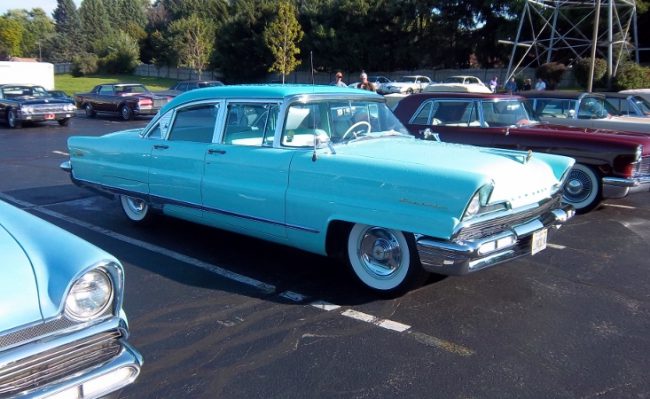
And clearly a Lincoln, as it would look nothing like its Ford and Mercury family members. It would be worth the wait.
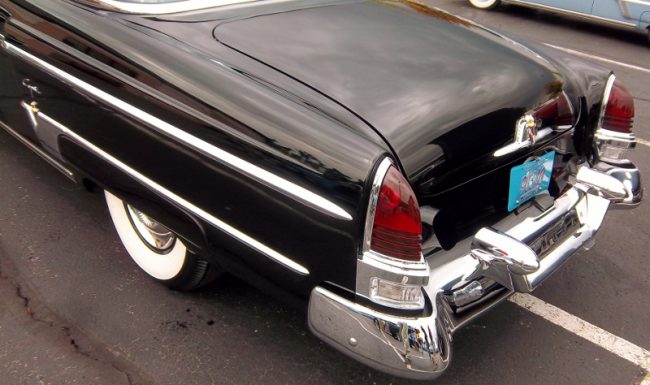
This showroom condition black over blue Capri hardtop was spotted by your author at the 2014 Mid-American Meet of the Lincoln and Continental Owners Club, held that September, in Rockford, Illinois. I was especially drawn to the color combination. That tuxedo black finish really made all the chrome jewelry pop!
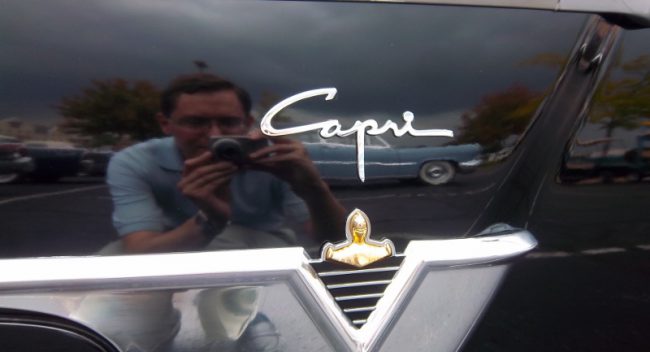

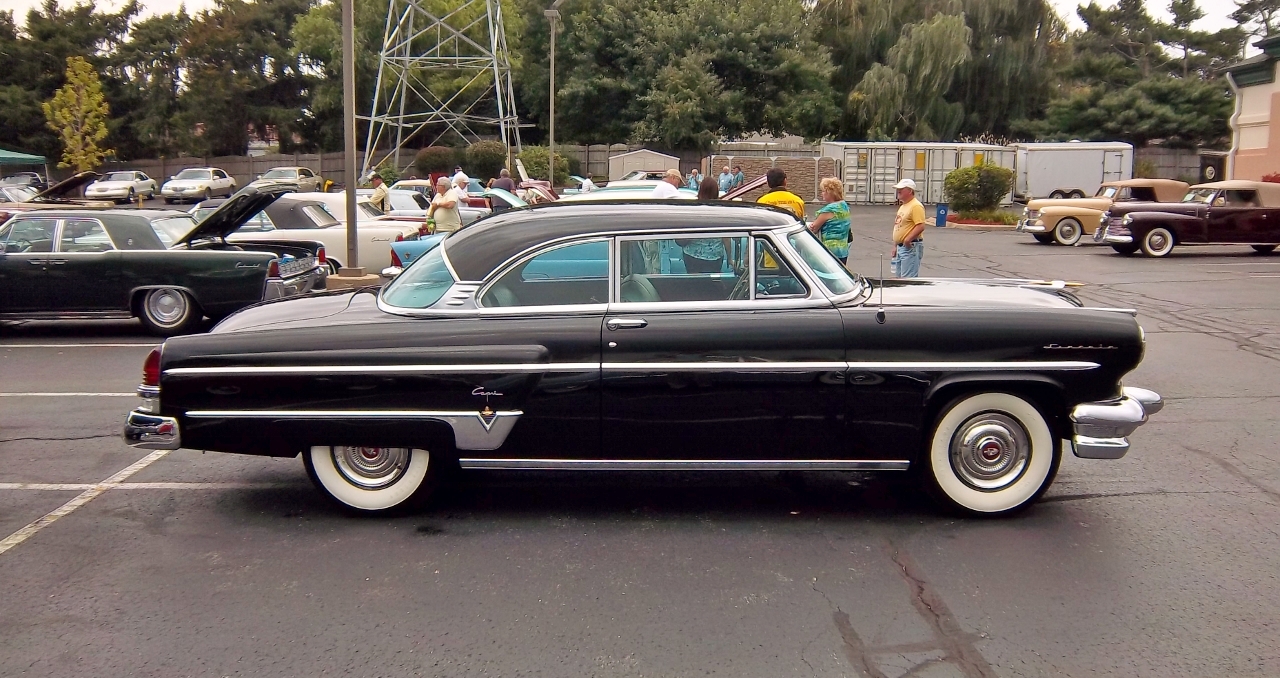
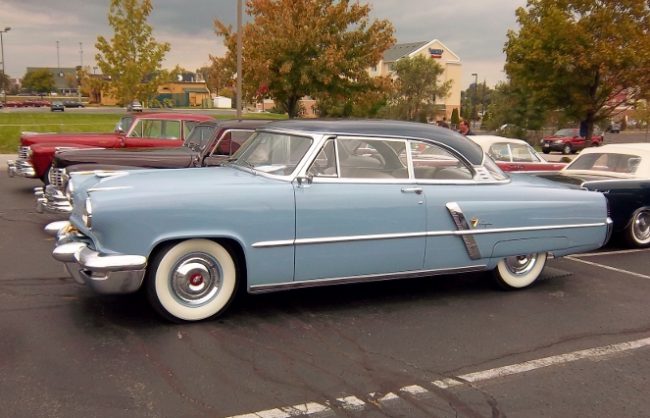






22 Comments
It would have been cool if Lincoln had stuck the Carrera name on a few much later models like Porsche did. It was a 356 not a 911 that had at least a class victory in Mexico, yet for over 50 years it has been 911s dubiously making the connection. Imagine say a 79 Town Coupe’ sporting an ever so slightly more relevant Carrera label on it. It would have really had the Germans muttering to themselves.
Sort of like all those wins that Pontiac had at LeMans. How I remember them.
Why would the Germans mutter to themselves? Lincoln would have used the name for years, blocking Porsche for using it in the first place. If you mean in 1979 Lincoln had stuck a Carrera label on a car after Porsche had been doing it for years, the same thing would have happened.
Both sides, depending on the who used it first, would say “We can’t because they have an on-going history with it.” Or, “See you in court.”
GM was sued over the Chevrolet Beretta. Out of court settlement – but GM paid 500K to a Beretta charity.
The Carrera win, in the upside down bathtub and golf cart class, obviously means a great deal to Porsche as it justifies Dr. Porsche’s ideas of minimalism. That was clearly not how Lincoln won.The reminder of Lincoln wining would leave them muttering for sure. But yes the Germans are quite litigious and no doubt our Mexican friends would come around in their familiar pose, with their hand out when they realized it was their old race instead of the Italian marble.
Porsche started using the Carrera name on racing-engine-equipped 356s the year after the Panamericana ended. Less than a decade after the last 356 Carrera 2 they started putting the Carrera name on the highest performance variants of the 911 until 1983, when they started using it on base model 911s.
Lincoln could have tried putting Carrera on the Capri, but instead they couldn’t even be bothered maintaining a model with a relation to the class winners. The next Lincoln where the name might have made sense was the Mark VII LSC. Porsche would have had something to say about it by then; the race being so short-lived, the association with Porsche being so long. Continental was a great name also used by Porsche in 1955 on a 356 model. If you want to know what would have happened if Lincoln had taken Carrera for its own use, then Carrera would probably be as sporty in people’s minds as Continental is today. It isn’t always the name that matters. Maybe Lincoln should have built cars that connected with their heritage while providing what customers wanted like Porsche did.
Did the Lincolns that won the stock car sedan class in 1952 have flat-head engines?
To compare the Lincoln Capri to the LSC using Dr. Porsche’s minimalist criteria, Lincoln would have remained a lot closer in weight and horsepower than the cars Porsche put the name on. The 80s 911 was easily 50 percent heavier than the race class winner and was only faster by adding displacement and horsepower, American style. So Lincoln wins, admittedly through the sad trick of putting their name on a Fairmont.
You made a good point how the Carrera name dropped down the model line like Bel Air or LTD on American big cars. I had forgotten that
Lincoln wins so much that people still wonder if it has a future, while Porsche has been a cash cow for VW ever since they simplified their production processes in the ’90s. As a fan of West German cars, I’m no more interested in what Porsche offers today than I am in what Lincoln does. What matters to VW is that there are lots of people with good money and credit who do like what they offer now, while Lincoln…is hoping that this generation of rebadged Explorers will be the one to turn the longest brand slide in history around.
Saying the LSC maintained parity with a thirty year old car isn’t going to impress anyone. The 1985 911 Carrera weighed about 2,750 lbs and had 214 hp. It could hit 149 mph and accelerate like nothing else on the US market. It was considerably faster than any 356 ever raced in the ’50s, and did so with all the amenities of the LSC. While a 1985 Lincoln MK VII LSC may have been a match for a 1954 Lincoln Capri in a race, the 911 Carrera was fifty percent faster than the 1954 356 that it evolved from.
I’m not sure where you’re getting this ‘Dr Porsche’s minimalist criteria’ theory. He was in a French prison when the first 356 was built and then he died in 1951. The competition cars he built prior to WWII were often incredibly complex and powerful. The top racing class had a maximum weight restriction, such was the belief in more exhibited by Ferdinand and his peers.
Just for clarity: the Navigator spends fewer unsold days on dealer lots than any Porsche product without a GT3 badge.
Ford makes half as many Navigators as they did in 2004. Are they willfully self-destructing? There are plenty of expensive cars in this area, but I didn’t know what a new Navigator looks like until I just did a search for information about them.
Carrera Town Coupe with velour and opera windows. Haha.
I’d still love to know if the Lincoln that finished two and a half hours between the winning Mercedes and almost half an hour ahead of the first Chrysler hemi in 1952 was a flat-head. Did you learn which engines the racing Capris had that year while researching this article?
The first Lincoln was two and a half hours behind the first Mercedes in 1952, for clarity.
The Capri according to my reference debuted in 52 with the new overhead valve V8 that was just Lincoln that year. It developed about five percent more horsepower from 6 percent less displacement than the previous flathead. A more interesting question was whether Lincoln was whipping up lightweight aluminum bodywork for it’s racers like the ringers Porsche and Mercedes sent. Remember that while the first few and the later racers were aluminum the 356s the hippies bought were steel with body production farmed out to recaro, the seat people.
The point of the race was to promote the new Pan American Highway to American tourists, so classes of racers were required after more highly backed teams started showing up. The Mexicans wanted to make money off the modern highway America had built for them..
With an Italian Carrera marble numbered plate on the dash to confuse the Mexicans and an 8 track tape of old Blue Eyes singing a cover of “Hot Rod Lincoln”, can’t loose. Even hippies will want to make amends for their friends all driving Porsches.
Simple, elegant and refined. Excellent years for Lincoln and Mercury. I’m sure Cadillac whipped them in the showroom.
I love me some vintage cars but the thought of driving one of these at speed, on bad roads, on bias-ply tires, makes me pucker .
Stock they were very nice indeed .
-Nate
I agree with Nate. I can’t imagine muscling one of these beauties on primitive roads. Then again, given the state of infrastructure decline in the US, we might need to revert back to vehicles such as this.
Shocktastic,, I’m willing to bet that it wasn’t even a little terrifying in the early ’50s, just as things my friends and I did in the ’80s that now make little Marxist muppets claim “survivor bias” didn’t cause anyone worthy of their balls to wet themselves then. Sure, there can be a learning curve involved in becoming a big chicken. Still, I’d rather be an adrenaline junkie than worried about the frailty of modern technology relative to something that doesn’t exist yet. I also understand that this doesn’t extend to watching your kids risk their lives, but the payoff for being a wuss today is increasing looking like an opportunity to live in Venezuela tomorrow.
You have to have actually driven these old boats when they were just regular cars to understand ~ back then there were no gash charged shocks, polyurethane suspension bushings, decent tires and so on .
One of my buddies bought a Porsche 356 Coupe new in 1956 to go racing with, he told me the 4″ wide white wall tires he slapped on it were the best tires he could find at that time .
Driving old vehicles fast -is- fun ~ it’s what I do as I don’t own any modern vehicles but at the very least I up date the tires, shocks and suspension bushings first as I have the experience of sliding boats like this around tight back roads, exciting yes but better do do it with to – day’s tires & things, even on the old tech suspension .
-Nate
I suspect those old Lincolns and Chryslers probably held up better and handled the rough Mexican roads better than most modern SUVs would. It is amazing to watch the old TV ads on YouTube where they take regular cars and drive through swamps and beaches and rough fields to show how tough they were, in other words far more severe usage than most SUVs are designed to handle.
It might seem scary today, but back then nobody knew about seatbelts, airbags, crush zones, and “bulletproof” radial tires, so you went fast on bad roads with what was available, and some died in the process. I would much rather crash in a Lincoln, however, than those Porsche Spyders or most other sports racing cars of that time that would fold up like a wet paper box if crashed, and had no roll bars or seat belts even though they were designed for racing.
Thanks for sharing the pictures Tom – those Carrera Lincoln’s were very well built and well engineered cars that are not seen very often these days.
Tom,
Remember meeting you at the meet!
Thanks for the Great article on the 52-55 Lincolns and showing so much of the Black 54 Capri! I own that car. Purchased it in 1998, I restored it myself. Has 50,000 original miles! Iput on 4-ply white wall tires, car drives like a dream, smooth riding.
I had a ’53 convertible with a mcculloch supercharger, Herbert roller tappet cam, mallory magspark ignition, octa-gane alcohol injection, marvel inverse oiler, and headers. tore the tread off a few tires at 125+mph in oklahoma summers using the owner’s manual 24psi tire pressures. Goodyear double eagles changed their tread pattern from separate little diamonds to a rib design because so many big cars in oklahoma, texas, Arizona, etc. had this same failure. I saw stacks of ruined double eagles in the tire dealer’s garage. anorak fact: Lincoln didn’t publicize that their late ’52s had about 180 hp with the bigger-valve “’53” cylinder heads they installed earlier than planned